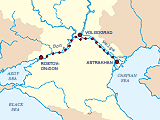
2000 — The fifth stage of the Rus-project
Date: June 26 — July 26, 2000
Route: Rostov-on-Don (Rus) — Volgograd (Rus) — Astrakhan (Rus)
In summer of the year 2000 the Vikings from the Smolensk sport-expeditionary Viking-Nevo club continued the participation in the international Rus-project by the Viking ship Heimlosa Rus from Rostov-on-Don to Volgograd and then to Astrakhan. During 32 days a thousand kilometers way was passed along the Don river, difficult system of the Volga-Don Canal and lower reach of the Volga river.
On the first stage of the voyage 2000 the crew of the ship consisted of seven Finns, one Swede and five Russians — Sergey Suhoruchenkov, Max Pryazhevsky, Anatoly Kabanov, Vladimir Grushenko and Michael Rigenkov. Other Vikings from Smolensk joined the expedition in Volgograd. The common gathering of the expedition participants took place in Rostov-on-Don in yacht-club Rostselmash where the Viking ship Heimlosa Rus spent the winter after brave voyage through the two seas.
Organizers of the expedition:
- Rus-farers Association (Finland);
- Sport-expeditionary club “Viking-Nevo” (Smolensk, Russia).
The crew of the ship:
- Fredrik Koivusalo, captain, the leader of the Rus-project (Finland),
- Sergey Suhoruchenkov, the leader of the Viking-Nevo club (Russia),
- Gustaf Duell (Sweden),
- Mikko Inkinen (Finland),
- Taina Mannila (Finland),
- Petri Rantapää (Finland),
- Seppo Suhonen (Finland),
- Topi Tapaila (Finland),
- Pentti Yrjänäinen (Finland),
- Vladimir Grushenko (Russia),
- Anatoly Kabanov (Russia),
- Max Pryazhevsky (Russia),
- Michael Rigenkov (Russia),
- Dmitry Baklanov (Russia),
- Kostya Golovkin (Russia),
- Irina Kosminina (Russia),
- Sasha Rizhkin (Russia),
- Sasha Smolevsky (Russia),
- Yuriy Smolevsky (Russia),
- Tanya Suhoruchenkova (Russia),
- Olga Titova (Russia),
- Igor Tihomirov (Russia),
- Iliya Fokin (Russia),
- Olesya Hazhieva (Russia).
During the first days of the voyage when the ship was going up-stream of the Don river, the crew had to row hard. But the fair wind blew soon and let to take up the sail and enjoy the beauties of the Don river banks in full measure. Flora and fauna of the Don river is very rich — there are a lot of birds in the sky and the nets are always full of fish. Many typical Cossack villages were met during the sailing and the crew of Heimlosa Rus even took part in the wedding ceremony in one of them. One of the crew-members — Pentti Yrjänäinen from Finland — played domra very well so the nice music could be heard on board during the whole sailing along the Don river.
To get from the Don river to the Volga river the Volga-Don Canal must be passed. The Canal consists of several artificial lakes and 18 locks. There are many severe limitations for foreign vessels when crossing the Canal. For example in 1998 the yacht of a famous sea-researcher and traveler Cousteau could not get to the Caspian Sea through this Canal and they had to find another way. Besides the change of the Russian crew was planed in Volgograd so during passing the Volga-Don Canal only one Russian crew-member, Max Pryazhevsky was on board. But in spite of everything the sailing along the watershed of the two rivers finished well and Heimlosa Rus reached Volgograd successfully. The distance of 550 kilometers was covered in all.
In expectation of the new crew-members coming Heimlosa Rus spent several days in Volgograd on the berth of the local fishing inspectors. The participants of the expedition visited a lot of historical places of the city and of course the most famous Monument of the Motherland (Mother Rodina) and the “Memorial to the Heroes of Stalingrad Battle”, situated on Mamaev Hill. The Monument of the Motherland is the tallest freestanding statue in the world. This statue is three times bigger than the Statue of Liberty, and has become the symbol of Volgograd. Soon the crew of the ship was enlarged with the young Vikings from the Smolensk Viking-Nevo club, and on July 14 Heimlosa Rus continued its voyage to Astrakhan. Newly arrived Russians divided into two groups. One of the groups took the oars immediately and another went to the agreed place on a half way to Astrakhan for the further change.
The experience and skills of the camping trips and competitions served its purpose in adaptation of young Vikings to severe conditions of the expedition. The travelers had to get over the head wind and waves along the whole way downstream of the Volga river which became too hard soon. The crew had to change the kind of travel — to row during the nights when the wind was going down and to have a rest during the day time. Mercilessly shining sun and 40-degrees heat gave a lot of problems also. But all the difficulties were generously recompensed with the views of the banks and the reaches of the great river. The Volga river has a lot of branches downstream that gives it the unique loveliness. Relatively narrow in the branches part the Volga river gets suddenly one kilometer wide after junction.
The foodstuff was not a problem for the crew. The nets were still full of fish including sturgeons, and the fresh eggs, curds and sour cream could be always found in the small villages on the river banks. And local people gladly changed the food for the seeds which were many on Heimlosa Rus board as the present to Vikings from the captain of the big dry cargo ship in one river-port on the Don river.
Astrakhan met the expedition gaily and with the big interest. The Northern Viking ship reached so remote south point for the first time during last thousand years. On time of Heimlosa Rus coming several TV-programs and newspaper reports about the expedition appeared in the city. In Astrakhanthe crew-members got the invitation from the Russian Geographical Association to continue the voyage on the Caspian Sea in summer 2001 with the purpose of archaeological and ecological research.

























